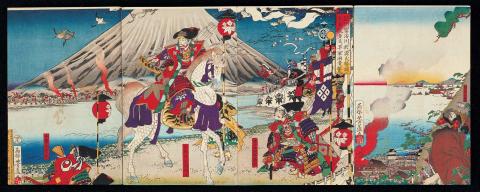ESSAY: YOSHIFUJI, Utagawa; Album of battles of the Genpei War
'Chivalry is a flower no less indigenous to the soil of Japan than its emblem, the cherry blossom; nor is it a dried-up specimen of an antique virtue preserved in the herbarium of our history. It is still a living object of power and beauty among us; and if it assumes no tangible shape or form, it not the less scents the moral atmosphere, and makes us aware that we are still under its potent spell ... The light of chivalry still illuminates our moral path...'(1)
The early Meiji period was marked by clashes between disputing samurai forces, which held differing views on the end of Japan's self-imposed isolation and on the changing relationship between the Imperial Court and the Tokugawa shogunate. In 1868, the shogunate was overthrown by a radical movement led largely by young samurai. This major battle was one of the last fought by the samurai and marks an important moment, after which - with the reinstatement of Emperor Meiji - Japan plunged headlong into a program of rapid modernisation and nation-building.
This album of prints illustrates this period of domestic unrest; the leader becomes a fugitive and eventually surrenders to a younger successor. The elaborate action scenes are interspersed with peaceful domestic depictions and joyful bouts of sumo wrestling. Yoshifuji's use of embossing, bronze highlights and other shimmering pigments exemplifies the highly sophisticated process of ukiyo-e printmaking during the Meiji period.
1. Inazo Nitobe, 'Bushido: The soul of Japan', December, 1904.
